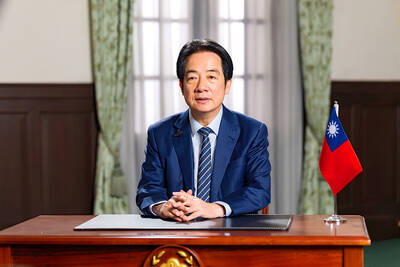On Saturday, Taiwan was the focus of activities in Schipluiden, a small village between The Hague and Rotterdam in The Netherlands.
The occasion was the unveiling of a monument commemorating Reverend Anthonius Hambrouck, who was a pastor in the old church in the village from 1632 until 1647, when Hambrouck left with his wife and four children, and sailed to faraway Formosa (a journey of almost one year). The church and the pulpit in the church remain the same as when Hambrouck left in 1647.
In Formosa, the Dutch East India Company had established its Fort Zeelandia in 1624 and built up a prosperous colony. Part of the work of the colony was to bring the gospel to the Aboriginal Siraya people, and establish schools and medical clinics in the area around today’s Anping (安平) in Tainan.

photo courtesy of Gerrit Van Der Wees
The first pastor to work in the area was Reverend George Candidius, who arrived in 1627 but refused to live at the fort, and instead made Sincan (present-day Sinshih District, 新市區) his home.
When Hambrouck arrived in 1647, he set up his parish in Mattau (today’s Madou District, 麻豆區) which in the early years had been hostile to the incoming Dutch — and at war with neighboring villages such as Sincan — when Candidius had been the pastor.
Hambrouck started preaching, and also began a school, and initially had some 145 male students, who received education “from the cock’s crowing.” The education gradually expanded, and Hambrouck started classes for girls and women in the afternoon. He trained a number of Aboriginal men as assistant teachers.

photo courtesy of Gerrit Van Der Wees
The ceremony in Schipluiden honored Hambrouck for his work, and particularly his role in establishing the written version of the Siraya language, which is currently undergoing revival efforts.
The plaque that was jointly unveiled by Taiwan representative Tom Chou (周台竹) and current Schipluiden pastor Erika Dibbets-van der Roest shows text taken from the Bible’s Gospel of St. Matthew in both old-Dutch and the Siraya language. The piece of art was a work by a former resident of Schipluiden, Marcel Koeleman.
The village of Schipluiden also decided to honor Reverend Hambrouck by naming the square in front of the church “Hambrouckplein” (Hambrouck square). The mayor of the village, Arnoud Rodenburg, and the town’s councilmember for culture and monuments Wendy Renzen jointly unveiled the new name plate.
Hambrouck became most famous in his role as intermediary after the landing of Cheng Cheng-kung (鄭成功, also known as Koxinga) in late April 1661. Koxinga and his 25,000 invading troops had been able to occupy the countryside area around Fort Zeelandia, but not the heavily defended fort itself.
Koxinga arrested and imprisoned some 500 Dutch who lived in the 40 villages around Fort Zeelandia, and selected Hambrouck to go to the fort and ordered him to convince Governor-General Frederic Coyett to surrender. Koxinga kept Hambrouck’s wife, one daughter and son as hostages. The other two married daughters lived at the fort.
When Hambrouck met Coyett, he urged him not to surrender, but to hold out until reinforcements from Batavia (present day Jakarta) would arrive. His two daughters at the castle begged him to stay (a big painting at today’s Anping Old Fort depicts the scene), but Hambrouck wanted to safeguard the lives of his wife and son and daughter, and returned to Koxinga’s headquarters at Fort Provintia, handing Koxinga the negative answer of Coyett. Koxinga subsequently had Hambrouck killed.

This month the government ordered a one-year block of Xiaohongshu (小紅書) or Rednote, a Chinese social media platform with more than 3 million users in Taiwan. The government pointed to widespread fraud activity on the platform, along with cybersecurity failures. Officials said that they had reached out to the company and asked it to change. However, they received no response. The pro-China parties, the Chinese Nationalist Party (KMT) and Taiwan People’s Party (TPP), immediately swung into action, denouncing the ban as an attack on free speech. This “free speech” claim was then echoed by the People’s Republic of China (PRC),

Most heroes are remembered for the battles they fought. Taiwan’s Black Bat Squadron is remembered for flying into Chinese airspace 838 times between 1953 and 1967, and for the 148 men whose sacrifice bought the intelligence that kept Taiwan secure. Two-thirds of the squadron died carrying out missions most people wouldn’t learn about for another 40 years. The squadron lost 15 aircraft and 148 crew members over those 14 years, making it the deadliest unit in Taiwan’s military history by casualty rate. They flew at night, often at low altitudes, straight into some of the most heavily defended airspace in Asia.

Many people in Taiwan first learned about universal basic income (UBI) — the idea that the government should provide regular, no-strings-attached payments to each citizen — in 2019. While seeking the Democratic nomination for the 2020 US presidential election, Andrew Yang, a politician of Taiwanese descent, said that, if elected, he’d institute a UBI of US$1,000 per month to “get the economic boot off of people’s throats, allowing them to lift their heads up, breathe, and get excited for the future.” His campaign petered out, but the concept of UBI hasn’t gone away. Throughout the industrialized world, there are fears that

The Democratic Progressive Party (DPP) controlled Executive Yuan (often called the Cabinet) finally fired back at the opposition-controlled Legislative Yuan in their ongoing struggle for control. The opposition Chinese Nationalist Party (KMT) and Taiwan People’s Party (TPP) acted surprised and outraged, but they should have seen it coming. Taiwan is now in a full-blown constitutional crisis. There are still peaceful ways out of this conflict, but with the KMT and TPP leadership in the hands of hardliners and the DPP having lost all patience, there is an alarming chance things could spiral out of control, threatening Taiwan’s democracy. This is no